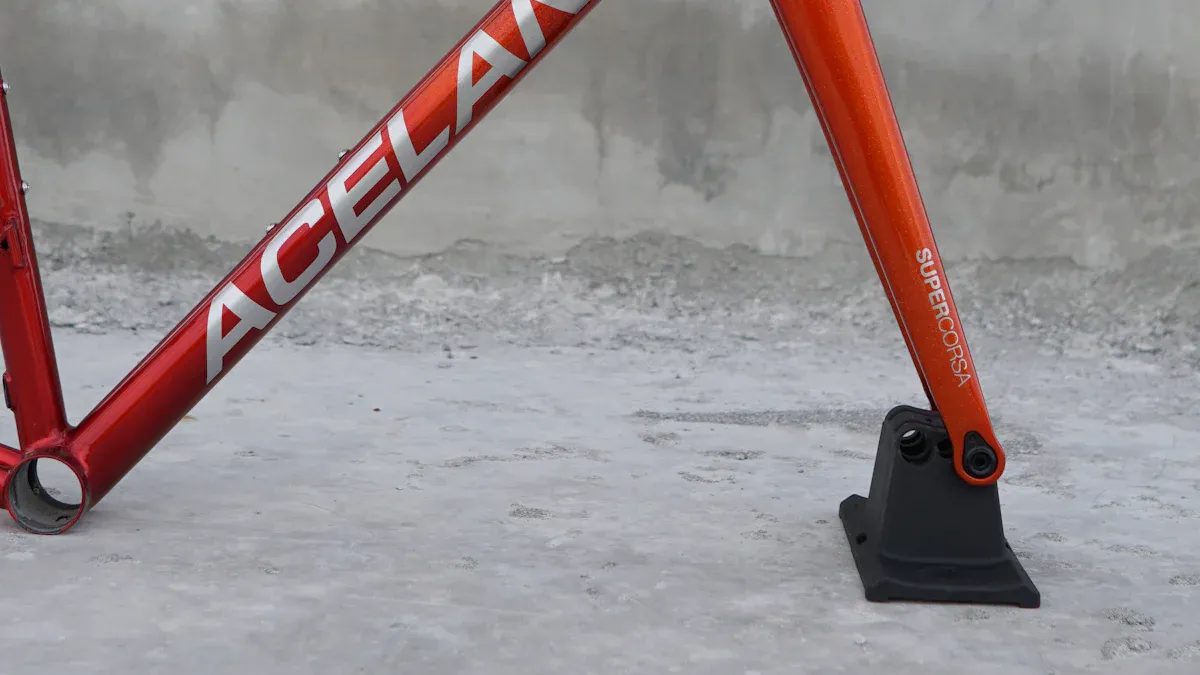
When you search for your first sport bike, you may wonder which sport bike frame material is best for you. Most beginner bikes feature aluminum sport bike frames. Aluminum is light and affordable. Steel sport bike frames provide a smooth ride and are easy to repair. Carbon fiber and titanium sport bike frames offer unique benefits but come at a higher cost and require more maintenance. The sport bike frame material impacts the bike’s weight, comfort, and durability. Understanding these factors helps you choose the right sport bike frame for your needs.
Key Takeaways
Aluminum and steel frames are good for new riders. They are light, strong, comfortable, and not too expensive. Chromoly is a special kind of steel. Aluminum frames are light and stiff. They do not rust easily. But they can feel bumpy on long rides. They are also hard to fix if they break. Steel frames give a smooth and comfy ride. They are easy to repair. But they are heavier. You must keep them dry to stop rust. Carbon fiber and titanium frames are also light and strong. They feel great to ride. But they cost more money. They also need special care. Try out different bikes before you buy one. Pick a frame that fits your money, comfort, and how you want to ride. This will help you have the best time.
Sport Bike Frame Materials
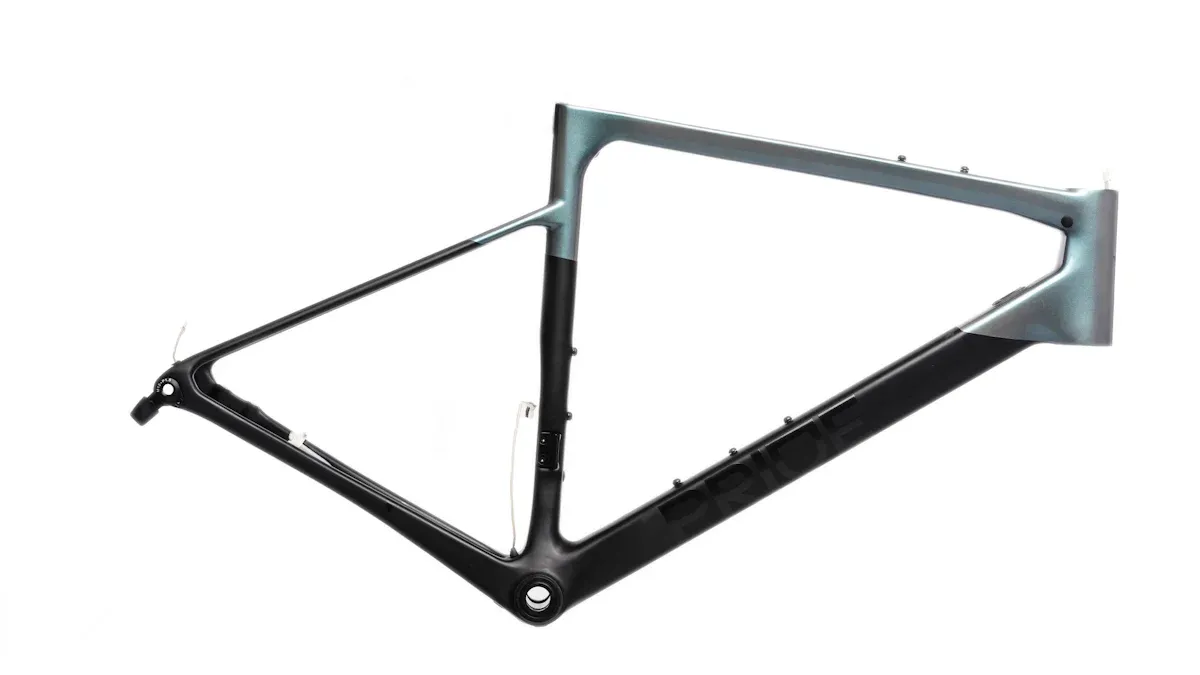
Main Types of Bike Frame Materials
There are four main sport bike frame materials. These are steel (including chromoly), aluminum, titanium, and carbon fiber. Each one makes the bike feel and work differently. You can check their main features in the table below:
Material | Defining Characteristics |
|---|---|
Steel (including Chromoly) | Lets the frame flex a bit for a lively ride; strong and lasts long; easy to fix; can get rusty; heavier than aluminum and titanium |
Aluminum | Stiffer and lighter than steel; does not rust; stiff for quick power; can feel rough; not as good against wear; hard to fix |
Titanium | Not as stiff as steel but lighter; strong; does not rust; costs a lot; good against wear; hard to fix |
Made from graphite fibers and resin; very strong and light; can be made stiff; soaks up bumps well; very costly; hard to fix |
Tip: Most bikes use aluminum or steel frames. These are cheaper and easier to make. Titanium and carbon fiber frames cost more and need special tools.
You can also look at the chart below to compare stiffness, strength, and weight. This shows why some bikes feel lighter or stronger than others.
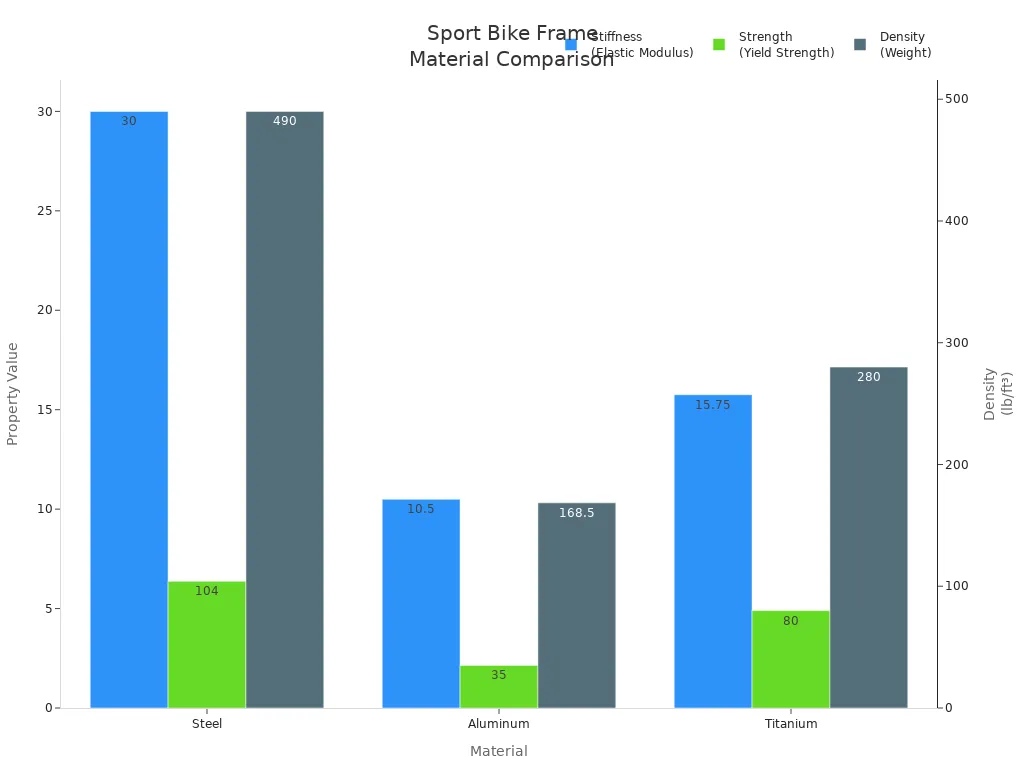
Why Frame Material Matters
The frame material changes how your bike feels and how long it lasts. Stiffness is how much the frame bends when you pedal hard. A stiff frame lets you go faster with less wasted energy. Strength is how much force the frame can take before it bends or breaks. Density means how heavy your bike feels when you ride or carry it.
If you want a bike that feels light and fast, pick carbon fiber or aluminum. If you want a bike that lasts long and is easy to fix, steel or titanium may be better. The right frame material helps you ride in comfort, control your bike, and keep it strong for years. Your choice of frame material will change how your bike feels and how much care it needs.
Aluminum Sport Bike Frames
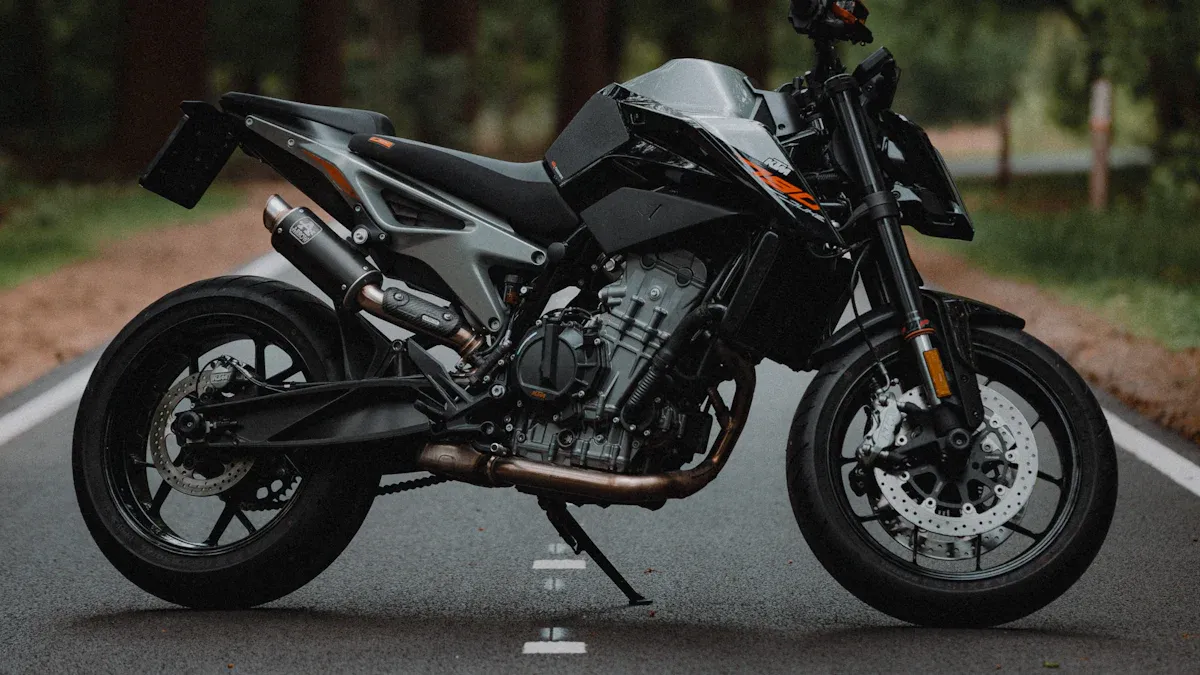
Overview of Aluminum Frames
You will see aluminum bike frames everywhere in sport bikes. Manufacturers use aluminum because it is light, strong, and stiff. These features help you handle your bike better and speed up quickly. Most beginner sport bikes, like the Aprilia RS 457, use an aluminum frame. This choice gives you a good mix of performance and price. Aluminum bike frames do not rust, so you do not need to worry about rain or wet roads. You will notice that aluminum bike frames feel lighter than steel frames. This lower weight makes it easier for you to lift your bike or move it around.
Note: Aluminum bike frames are popular in mountain and sport bikes. Their light weight and stiffness help you control your bike and enjoy faster rides.
Pros of Aluminum for Beginners
Aluminum bike frames offer many benefits for new riders. You get a bike that is easy to handle because of its low weight. Aluminum is tough, so your bike can take some bumps and keep going. You will spend less money on aluminum bike frames than on carbon or titanium frames. This helps you stick to your budget. Aluminum bike frames need less care than carbon frames. You do not have to check for cracks as often. Modern aluminum bike frames use new designs that make your ride smoother, even on rough roads.
Aluminum is light and strong, making your bike easy to ride.
Aluminum bike frames cost less, so you save money.
Aluminum bike frames resist damage from small crashes.
Aluminum bike frames need less maintenance.
New aluminum bike frames feel more comfortable than older ones.
Cons of Aluminum Frames
Aluminum bike frames have some drawbacks you should know. The stiff frame sends more road bumps and vibrations to you. This can make long rides less comfortable. Aluminum bike frames can get dents or cracks, especially near welds. If your aluminum frame breaks, you cannot fix it easily. You will need to replace it. Aluminum bike frames can wear out after years of use. They may fail suddenly without warning. You should check your aluminum bike frame often for damage. Overtightening bolts can strip threads in aluminum frames, causing problems.
Aluminum bike frames transfer more vibration, which can feel rough.
Aluminum frames are hard to repair and usually need replacement.
Dents and cracks can weaken the frame.
Aluminum frames may not last as long as steel frames.
Regular checks help you spot damage early.
Steel and Chromoly Bike Frames
Steel Frame Basics
Steel bike frames are a classic pick for sport bikes. They are known for being strong and comfy. Steel helps make your ride smooth by soaking up bumps. Many people like steel bike frames because they last a long time. If your steel frame gets damaged, you can fix it easily. Steel bike frames cost less than titanium or carbon fiber frames. Steel bike frames feel heavier than aluminum ones. This extra weight can make it harder to carry or pedal uphill. You need to take care of steel bike frames so they do not rust, especially in wet weather.
Tip: Steel bike frames are good if you want a bike that lasts and feels nice on bumpy roads.
Chromoly Steel Features
Chromoly steel is a special kind of steel for sport bikes. Makers add chromium and molybdenum to make it stronger and lighter. Chromoly steel bike frames weigh less and are stronger than regular steel frames. You get better speed and control with a chromoly frame. Chromoly steel soaks up shocks and bumps for a smoother ride. You will see chromoly steel bike frames on mid to high-end sport bikes. The alloy lets makers use thinner tubes, so the frame is lighter but still strong. Chromoly steel bike frames handle heat and stress well, so they last longer.
Property | Description |
|---|---|
Strength-to-Weight | Chromoly is strong and 20-30% lighter than regular steel. |
Toughness & Ductility | It bends and flexes without breaking. |
Corrosion Resistance | It resists rust a bit, but still needs care. |
Flexibility & Ride Quality | It soaks up bumps for a smoother ride. |
Durability | It can take lots of use and rough rides. |
Cost | It costs more than regular steel, but less than titanium or carbon fiber. |
Pros and Cons for New Riders
Steel and chromoly steel bike frames have good and bad points for new riders. You get a strong frame that can handle rough roads. Steel bike frames give a comfy ride by soaking up bumps. You can fix a steel frame if it gets damaged. Steel bike frames cost less and last a long time. Chromoly steel bike frames are stronger and lighter, so they are easier to handle.
But steel bike frames are heavier than aluminum or carbon fiber frames. You may need more effort to go uphill or speed up. Steel bike frames can rust, so you must clean and care for your bike often. Chromoly steel bike frames cost more than regular steel, but they work better.
Aspect | Pros | Cons |
|---|---|---|
Strength | Chromoly steel frames are strong and last long. | Steel frames are heavier than other types. |
Ride Quality | Steel frames soak up bumps for a comfy ride. | Steel can rust if you do not take care of it. |
Affordability | Steel frames are cheap and easy to fix. | Chromoly costs more than regular steel. |
Note: Steel bike frames are a great pick if you want a tough and comfy bike. Chromoly steel bike frames give you more strength and less weight for better rides.
Carbon Fiber Bike Frames
What Is Carbon Fiber?
You might ask why carbon fiber is special for sport bikes. Carbon fiber is made from very thin carbon strands. These strands are woven into sheets that look like fabric. Makers glue the sheets together with strong resin. This makes a material that is light and strong. The fibers start as polyacrylonitrile, which is heated and stretched. This turns them into tough filaments. When you see a carbon fiber bike frame, you see layers of these sheets shaped into a frame. This way, makers can change how stiff or bendy the bike feels. High-modulus carbon fibers like TORAYCA T700S and T1100G make frames strong and light. The resin adds more strength and helps keep the weight low. You get a frame that is great for racing and going fast.
Advantages of Carbon Fiber Frames
Carbon fiber bike frames have many good points for sport riders. Carbon fiber is the lightest bike frame material. This makes your bike easy to handle and quick to speed up. Carbon fiber is also very stiff, so your bike reacts fast when you pedal hard. Makers can shape carbon fiber to help your bike cut through the air. This helps you ride faster. Your bike will feel sharp and quick on the road. Every Tour de France winner in the last 20 years used carbon fiber bikes. This shows carbon fiber is best for racing. Carbon fiber frames can be made stiff in some ways and flexible in others. This gives you both comfort and speed.
Performance Aspect | Carbon Fiber | Aluminum |
|---|---|---|
Weight | Very light | Heavier |
Stiffness | Extremely stiff | Less stiff |
Agility | Excellent | Good |
Cost | High | Lower |
Tip: Carbon fiber gives you a fast and easy ride. These benefits make carbon fiber the top pick for racers.
Drawbacks for Beginners
You should know the downsides of carbon fiber before picking it for your first bike. Carbon fiber bike frames cost much more than aluminum or steel. Prices can go from $1,000 to $12,000. If you crash, carbon fiber can crack or break, and fixing it costs a lot. Repairs may cost $300 or more, and sometimes you cannot fix it at all. You need to clean your carbon fiber bike frame with gentle soap and water. Strong cleaners can hurt the resin. You must be careful when moving your bike so it does not get damaged. Using your carbon fiber bike on indoor trainers for a long time can also hurt the frame. For new riders, aluminum bikes are often tougher and easier to own. You can switch to carbon fiber parts later when you have more experience.
Note: If you want an easy start, try aluminum or steel before choosing carbon fiber.
Titanium Bike Frames
Titanium Frame Overview
Titanium bike frames are easy to spot because they look special. Titanium is not common, but it is strong, light, and lasts a long time. A titanium frame weighs about the same as carbon fiber. It is also stronger than steel. This means your bike will not rust or get damaged by rain. You can ride in any weather and not worry. The curved tubes on titanium frames bend a little when you ride. This helps soak up bumps and makes your ride smoother. Many titanium frames hide the cables inside the frame. This makes your bike look neat and new. New ways to make titanium frames, like 3D printing and CNC machines, let makers create cool shapes. You can even pick special colors or frame shapes for your bike. That is why many pro riders and people who want a special bike choose titanium.
Tip: Titanium bike frames can last a very long time. They do not get weak as you use them. You can ride in comfort and keep your bike looking nice with little work.
Titanium Pros and Cons
Titanium bike frames have lots of good things for sport riders. They are strong but not heavy. This means your bike is tough and easy to ride. Titanium frames help stop road bumps from making you tired. The metal soaks up shakes, so your ride feels smooth. You do not need to worry about rust, even in the rain. Titanium bike frames last for many years and do not wear out.
Here are the main pros and cons:
Pros of Titanium Bike Frames | Cons of Titanium Bike Frames |
|---|---|
Light and strong | Very expensive |
Does not rust | Hard to fix |
Soaks up bumps | Not many choices |
Lasts a long time | Needs special tools to fix |
Can be made special for you | Bends more than carbon fiber |
Titanium is heavier than aluminum, but it is still strong and light.
There are not many titanium bike frames because they are hard to make and cost a lot.
If your titanium frame breaks, it needs special welding and a skilled worker to fix it.
Some riders feel titanium frames bend more than carbon fiber. This can make the bike feel less stiff when you pedal hard.
Note: If you want a bike that is comfy, cool, and lasts a long time, titanium is a great pick. It costs more, but you get a bike that feels good every time you ride.
Bike Frame Materials Comparison
Comparison Table
Picking the right sport bike frame can be tricky. Each frame material has good and bad points. You might wonder how they are different. The table below shows how aluminum, steel (including chromoly), carbon fiber, and titanium compare in five main ways: weight, cost, durability, comfort, and maintenance.
Frame Material | Weight | Cost | Durability & Strength | Comfort | Maintenance Needs |
|---|---|---|---|---|---|
Aluminum | Lightweight; stiffer than steel; lighter than steel but heavier than carbon fiber | Affordable; lower cost than carbon fiber and titanium | Durable but less than steel; fatigues over time; difficult and costly to repair | Harsher ride quality; less comfortable on long rides compared to steel and carbon fiber | Low maintenance; no corrosion issues; difficult to repair when damaged |
Steel (Chromoly) | Heavier than aluminum and carbon fiber; can add 10-20 lbs to bike weight | Inexpensive relative to other materials | Very durable and strong; chromoly offers better strength-to-weight ratio; prone to corrosion | Comfortable due to compliance and vibration absorption; smooth ride quality | Requires regular maintenance to prevent rust; easier and cheaper to repair than aluminum or carbon fiber |
Lightest and stiffest frame material; can produce bikes as light as 11 lbs | Expensive; high cost due to materials and labor-intensive manufacturing | Good durability but can be damaged easily; repairs possible but costly | Excellent comfort due to compliance and vibration damping; highly customizable ride feel | Requires careful maintenance; damage can be expensive to fix; sensitive to impacts | |
Titanium | Lightweight, similar to steel but lighter; excellent strength-to-weight ratio | Very expensive; high material and labor costs; limited availability | Extremely durable; resists wear, fatigue, and corrosion; often comes with lifetime warranties | Very comfortable ride due to compliance; smooth and forgiving | Low maintenance due to corrosion resistance; repairs require expertise and can be costly |
Tip: If you want a bike that is easy to use, not too pricey, and simple to care for, aluminum and steel (especially chromoly) are smart picks for new riders.
What Makes a Material Beginner-Friendly?
Your first sport bike frame should be light, strong, and comfy for long rides. You do not want to spend a lot on repairs or hard upkeep. Here is how each material fits these needs:
Aluminum frames are light and not expensive. You can ride fast and carry your bike without much effort. Most starter sport bikes use aluminum. You do not need to worry about rust. Just check for cracks or dents sometimes. This makes aluminum a great choice for beginners.
Steel and Chromoly frames are heavier, but they last a long time. Chromoly steel is strong without being too heavy. Steel soaks up bumps, so your ride feels smoother. If you scratch or dent your frame, you can fix it easily. Keep steel clean and dry to stop rust, but repairs are cheap.
Carbon fiber frames are the lightest and stiffest. You get a special ride feel and lots of comfort. But carbon fiber costs a lot and needs gentle care. If you drop or crash your bike, repairs can be pricey. Most new riders wait until they have more skill before picking carbon fiber.
Titanium frames give a smooth, comfy ride and last for years. Titanium is strong and does not rust. But titanium frames cost a lot and are hard to fix. You will not see many beginner bikes made from titanium.
Maintenance and Long-Term Costs
Think about how much time and money you will spend on your bike. Aluminum and steel frames need less care than carbon fiber or titanium. Most riders pay less each year if they clean their bike and check for damage. Steel frames need extra care to stop rust, but you can fix them easily. Carbon fiber and titanium frames need special repairs, which cost more and take longer.
Road bikes with aluminum or steel frames usually cost about $185 each year for basic care.
Mountain bikes or bikes with fancy parts can cost up to $630 a year, especially if you ride hard or need suspension work.
Custom frames or bikes with special parts may need more care and higher repair bills.
Which Materials Suit Beginners Best?
You want a sport bike frame that is light, strong, and easy to care for. Aluminum and chromoly steel frames fit these needs. They give you good strength, low cost, and simple upkeep. You can enjoy a smooth ride and fix your bike if something breaks. Carbon fiber and titanium frames have special features and high performance, but they cost more and need more care. Most new riders start with aluminum or steel and upgrade later if they want a custom bike.
Note: Pick a frame that fits your needs and budget. You can always switch to carbon fiber or titanium later if you want a special bike or better performance.
Frame Material and Ride Quality
Comfort and Vibration
You may think frame material makes your bike comfy. Many people say steel, aluminum, titanium, and carbon fiber all feel different. But studies show this is not always right. The comfort and how much vibration you feel depend more on the frame’s shape and size. The material does not matter as much. Carbon fiber frames can feel smoother because they have flex zones. Makers design these zones to bend a little. Adding damping stuff to the frame does not stop vibrations much. The handlebars and forks change the shakes you feel in your hands. The frame and wheels matter more for the seat. You should try riding different bikes to see what feels best for you.
Tip: Do not pick a bike just for its frame material. Test different bikes and look at the whole design.
Weight and Handling
The frame’s weight changes how you ride your bike. Lighter frames help you go faster and make turning easier. Aluminum and carbon fiber frames are lighter than steel frames. Titanium frames are strong and not too heavy. You will notice a lighter frame helps you climb hills and turn quickly. Stiff frames react fast but can feel rough on bumpy roads. Pick a frame that fits how you like to ride and where you ride most.
Lighter frames are easy to lift and help you speed up.
Stiff frames work better but can feel rough on bad roads.
Durability and Maintenance
Frame material matters for how long your bike lasts and how you care for it. Steel frames are tough and can take hits but need care to stop rust. Aluminum frames are light and stiff but can wear out over time. Carbon fiber frames last long if you clean them gently and check for damage after crashes. Titanium frames are light and strong and do not rust, so they need little care. Keep your bike dry and check for damage often. Fixing problems early keeps your bike safe and strong.
Frame Material | Durability | Maintenance | Notes |
|---|---|---|---|
Steel | Very tough; resists dents | Needs anti-rust care | Easy to fix |
Aluminum | Light; wears out faster | Watch for rust | Less comfy on long rides |
Carbon Fiber | Strong; damage can hide | Clean gently, check after crashes | |
Titanium | Very tough; does not rust | Needs little care | Hard to fix |
Note: Taking care of your bike helps it last longer. Clean it, check for damage, and store it well to keep your ride smooth.
Choosing a Sport Bike Frame
Budget and Value
When you shop for your first sport bike, think about how much money you can spend. The frame is the most important part of your bike. You cannot swap it out later, so pick the best frame you can buy. Most beginner sport bikes have aluminum frames. These bikes cost less and work well for new riders. You will see many bikes priced between $875 and $1,200. Aluminum frames are light and stiff. This helps you ride faster and steer easily. Some bikes use aluminum frames with carbon forks. This mix gives you more comfort but does not cost much more.
Here is a table that shows the price range for beginner sport bikes with different frame materials:
Frame Material | Typical Price Range | Characteristics and Impact on Value for New Riders |
|---|---|---|
Aluminum | $875 – $1,200 | Light, not expensive, stiff, great for beginners; most common in budget bikes; good mix of weight and price. |
Steel | N/A | Heavier but smoother and more comfy ride; better for rough roads or long trips; not as common in beginner bikes. |
Carbon | Usually above $1,200 | Very light and smooth ride; found in more expensive bikes; costs more. |
You can see that aluminum frames give new riders the best deal. Here are some popular beginner sport bikes:
Example Entry-Level Sport Bikes | Price | Notes |
|---|---|---|
Tommaso Imola | ~$875 | Aluminum frame, Shimano Claris parts, good for new riders. |
Giant Contend 3 | ~$950 | Alloy frame, relaxed shape, comfy for beginners. |
Specialized Allez | $1,000 – $1,200 | High-quality aluminum frame, race shape, can upgrade parts. |
Decathlon Triban RC 520 | ~$1,100 | Aluminum frame with carbon fork, Shimano 105 parts, comfy and fast. |
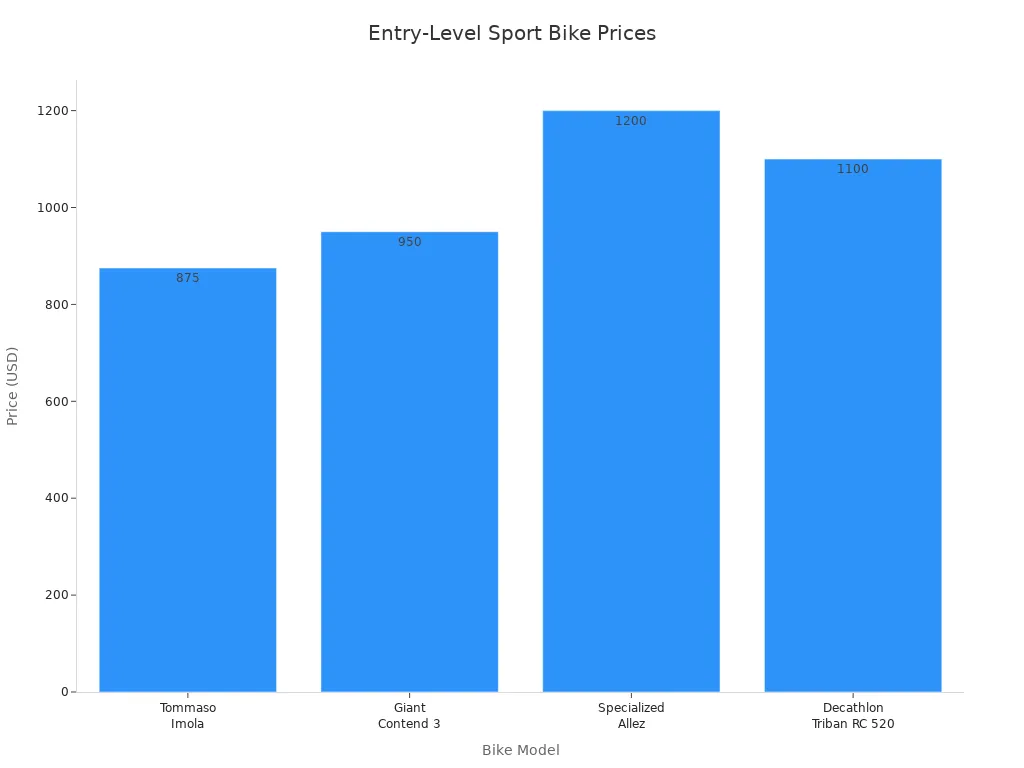
Tip: Focus on getting a strong frame. You can change wheels or gears later. A good frame lasts longer and gives you better value.
Comfort and Intended Use
Think about how you want to use your bike. If you want to race, look for a frame that is light and stiff. Carbon fiber frames are best for racing. They help you go fast and soak up bumps. If you want to ride for fun or exercise, aluminum frames are a good choice. Aluminum frames are light and easy to control.
Steel frames are good for riding to work or long trips. They are heavier but make your ride smoother. Steel frames last a long time and handle rough roads well. Titanium frames are strong, light, and do not rust. These frames cost more and are for people who want a special bike.
Here are some ways your use changes your choice:
Racing bikes need light, stiff frames like carbon fiber or titanium.
Bikes for fun or exercise work well with aluminum frames.
Commuter bikes use steel frames for strength and comfort.
Touring bikes often use titanium or steel frames for long trips.
Note: The shape of the frame also changes how your bike feels. Racing frames put you lower. Commuter and touring frames let you sit up straight for comfort.
Maintenance Needs
Each frame material needs different care. You should know what to expect before you buy. Steel frames need cleaning to stop rust, especially if you ride in rain or snow. Aluminum frames do not rust, but they can get dents or cracks. You cannot fix aluminum frames easily, so check for damage often.
Carbon fiber frames need gentle cleaning and close checks after crashes. Damage can hide inside the frame, so look carefully. Titanium frames do not rust and last a long time. If a titanium frame breaks, only a skilled worker can fix it.
Here is a table that shows the main care needs for each frame material:
Frame Material | Key Maintenance Needs |
|---|---|
Steel | Needs cleaning to stop rust, especially in wet weather. |
Aluminum | Can get damaged from bumps; hard to fix dents or cracks. |
Carbon Fiber | Needs careful checks after crashes; can break inside. |
Titanium | Very tough and does not rust, but hard to fix if broken. |
Tip: Clean your bike often and look for damage. Good care helps your bike last longer and keeps you safe.
Making Your Choice
Think about your money, comfort, and how much work you want to do to care for your bike. Experts say to look at weight, strength, comfort, and price. Aluminum frames are light and do not rust. They are good for speed and easy to move. Steel frames are heavier but last longer and give a smoother ride. Carbon fiber frames are very light and soak up bumps, but they cost more and can break if hit. Titanium frames are light and strong, but cost a lot and are hard to fix.
Here is a table that shows what beginners should think about:
Frame Material | Advantages | Disadvantages | Environmental Impact | |
|---|---|---|---|---|
Aluminum | Light, does not rust, price | Light, does not react, not expensive, good for speed | Stiff ride, less comfy, medium impact on the environment | |
Steel | Strength, comfort, weight, price | Very strong, soaks up bumps, comfy, not expensive, good for the planet | Heavy, can rust, not as quick | |
Carbon Fiber | Weight, strength, smooth ride, price | Very light and strong, soaks up bumps well | Expensive, can break badly if cracked, high impact on the environment | |
Titanium | Mix of lightness, strength, rust-proof, price | Light, strong, does not rust, comfy | Very expensive, medium impact on the environment |
Try riding different bikes before you buy one. Test rides help you feel the difference between frames. Go to a bike shop and ask for help. How the bike fits you matters more than weight or brand. A good fit makes your ride comfy and safe. You can upgrade parts like wheels or brakes later. The frame stays the same, so pick the best one for you.
Tip: Take your time and try many bikes. Ask questions at the shop. Pick a frame that fits your money and how you want to ride. You will enjoy your bike more and get better value.
You now know the main differences between aluminum, steel, carbon fiber, and titanium frames. Aluminum and steel frames work best for most new riders because they offer a good mix of comfort, strength, and value. Think about how you want to use your bike and what feels best for you. Try different bikes at a local shop before you decide. Test rides help you find the right fit and make your first bike experience better.
FAQ
What is the best sport bike frame material for beginners?
You should start with aluminum or chromoly steel. These materials give you a good mix of low weight, comfort, and price. You can ride easily and keep your bike in good shape with simple care.
How do I know if my bike frame needs repair?
Check your frame for dents, cracks, or rust. Listen for new noises while you ride. If you see damage or feel something strange, visit a bike shop. Quick checks help you stay safe.
Can I upgrade my bike frame later?
You can upgrade your bike frame, but it often costs a lot. Most riders change parts like wheels or seats first. If you want a custom frame, talk to a local shop for advice.
Does frame material affect speed?
Frame material changes your bike’s weight and stiffness. Lighter, stiffer frames help you speed up and climb hills. Aluminum and carbon fiber frames often feel faster than steel frames.
See Also
Comparing Enduro Bike Frames For Durability And Strength
Track Bike Frame Materials And Their Importance Explained
Understanding Bike Frame Components And Their Key Roles
